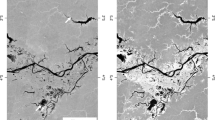Abstract
The classification of wetland vegetation classes is conditional upon the variety of species or community of species present and seasonal changes in the extent and duration of water and flooding patterns occurring within the landscape. The capability of detecting and mapping water flow under vegetation using synthetic aperture radar (SAR) enables information to be determined about the structure, composition and extent of surface vegetation types.
Fully polarimetric C, L and P –band SAR data was acquired over the Cambodian Tonle Sap Basin in September 2000 and interrogated to map thirteen wetland vegetation ecosystem classes at the western end of the Basin.
In a second example both SAR and optical imagery were used to map wetland vegetation on Lake Chilwa, Malawi.
Access provided by CONRICYT-eBooks. Download reference work entry PDF
Similar content being viewed by others
Keywords
Introduction
In many tropical wetlands, herbaceous vegetation dominates and may be seasonal in its distribution (e.g., because of different water flows). As an example, in western Cambodia, the flow of water from the Mekong River system into the Tonle Sap Great Lake (TSGL; Fig. 1) during the wet season (July to October) expands the surface area of the lake from 250,000 ha to 1.25 million ha, with this including large areas of adjacent forests and woodlands, macrophytes, and floating grasses. This flow into the TSGL occurs because the distributaries of the lower Mekong downstream from Phnom Penh are unable to cope with the wet season flood discharge flowing into the Gulf of Thailand; the waters back up and flow into the TSGL. With the reversal of water flow back into the Mekong system from November each year, large areas of flooded land on the lakes edge (often with herbaceous vegetation) are successively exposed and used for agriculture. In this fertile zone of migrating waters about 48,000 ha are planted with “receding rice” and another 24,000 ha with other field crops. This water draining back into the Mekong increases downstream flow by an estimated 16% providing much needed water for irrigation in southern Cambodia and Vietnam and reducing the risk of salinity intrusion upstream from the immediate tidal regions.
PACRIM-2 Mission
As part of the NASA-Australia sponsor PACRIM-2 mission, airborne Synthetic Aperture Radar (AIRSAR) data were collected over the Tonle Sap and Angkor regions of Cambodia during high water (Fig. 2). The imagery were first segmented using a modified Gaussian Markov Random Filed Model (Dong et al. 2001; Horn and Milne 2002), with each segment associated with attributes such as the mean and standard deviation. An ISODATA classification was then performed on the AIRSAR C-, L-, and P-band imagery to map 13 wetland ecosystems, including macrophytes, floating grasses, shrublands, open and closed forests, mangroves, and open water surfaces (Fig. 3). As well as extent, consideration was given to structural form (e.g., trees, shrubs), growth stage, and condition. The classification scheme was consistent with guidelines listed in the Asian Wetlands Inventory (Wetlands International) for describing wetlands and addressed the needs of the Tonle Sap Biosphere Reserve Act, which requires data and information to assist in formulating management plans for the core, buffer, and transition zones of the Prek Toal Nature Reserve. A limitation of the approach was the fully polarimetric C-, L-, and P-band data were used which are not always available and certainly not from spaceborne platforms. However, further analysis indicated that the three channel combination of C-band HH and L-band VV and HV captured 72.2% of the information (Milne and Tapley 2004).
Both SAR and optical data can be used to map dominant herbaceous wetland vegetation and are often used in combination, as in the case of the Lake Chilwa wetland in Malawi (Fig. 4; Rebelo 2010) and the flooded Várzea forests of the Amazon (Hess et al. 2010). Data from airborne hyperspectral imaging spectrometers has also proved popular as they offer both high spectral and spatial resolution imagery that is ideally suited to monitoring wetland vegetation. Data acquired by hyperspectral sensors such as the Compact Airborne Spectrographic Imager-2 (CASI-2) have also proved useful for mapping the distribution of wetland plant species. For example, Hunter et al. (2010) used these data to map macrophytes in the Upper Thurne region of the Norfolk Broads, UK.
References
Dong Y, Milne AK, Forster BC. Segmentation and classification of vegetated areas using polarimetric SAR image data. IEEE Trans Geosci Remote Sens. 2001;39(2):321–9.
Hess L. Habitat mapping for biodiversity and conservation on the Amazon floodplain. In: Rosenqvist A, Shimada M, editors. Global environmental monitoring by ALOS PALSAR: science results from the ALOS Kyoto & Carbon Initiative. Ref NDX-100004, Japan Aerospace Exploration Agency; 2010. p. 60.
Horn GD, Milne AK. Segmentation and classification of multitemporal data: methodology and results of a modified Gaussian Markov random field model classification system. IGARSS2002 Proceedings; 2002 June 24–28; Toronto; 2002.
Hunter PD, Gilvear DJ, Tyler AN, Willby NJ, Kelly A. Mapping macrophytic vegetation in shallow lakes using the Compact Airborne Spectrographic Imager (CASI). Aquat Conserv Mar Freshwat Ecosyst. 2010;20:717–27.
Milne AK, Tapley IJ. Mapping and assessment of wetland ecosystems in north-western Tonle Sap Great Lake with AIRSAR data: results of a pilot study funded jointly by the Mekong River Commission and University of New South Wales; 2004. p. 129.
Rebelo LM. Eco-hydrological characterization of inland wetlands in Africa using L-band SAR. IEEE J Spec Top Earth Observ Remote Sens. 2010;3(4):554–9.
Author information
Authors and Affiliations
Corresponding author
Editor information
Editors and Affiliations
Rights and permissions
Copyright information
© 2018 Springer Science+Business Media B.V., part of Springer Nature
About this entry
Cite this entry
Milne, T. (2018). Remote Sensing of Wetland Types: Tropical Herbaceous Vegetation. In: Finlayson, C.M., et al. The Wetland Book. Springer, Dordrecht. https://doi.org/10.1007/978-90-481-9659-3_304
Download citation
DOI: https://doi.org/10.1007/978-90-481-9659-3_304
Published:
Publisher Name: Springer, Dordrecht
Print ISBN: 978-90-481-3493-9
Online ISBN: 978-90-481-9659-3
eBook Packages: Biomedical and Life SciencesReference Module Biomedical and Life Sciences







